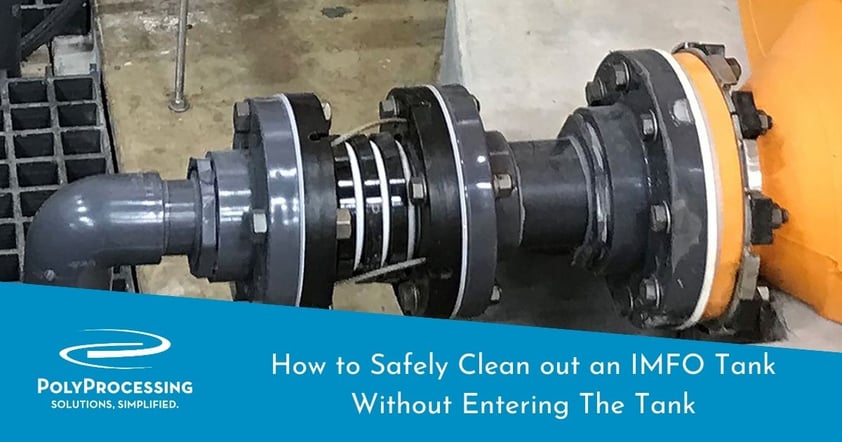How to Safely Clean out an IMFO Tank Without Entering The Tank
Can you name one of the most common things companies forget to consider when purchasing a tank?
Surprisingly, many operations don’t consider how they will fully discharge / drain their tanks before they make a purchase. It’s not until afterward that they realize the need to find a solution. However, this decision should be made in advance because it is a critical part of tank maintenance and chemical purity processes.

There are safe and effective methods for fully discharging your chemical tanks, and there are methods that can be hazardous or insufficient for your specific application. In this article, we explore the hazards of improper tank discharge and give our recommendations for ensuring a full and safe discharge system.
Hazards of Improper Tank Discharge
We’ve seen first-hand what happens when you can’t fully discharge your chemical storage tanks or if you use improper full-discharge practices. Improper cleaning methods can be hazardous to your chemicals, your equipment, and your personnel.
Let’s review three different situations, so your company can avoid common, improper outlet designs.
1. Residual chemicals and free radicals
If your chemical storage tank does not fully discharge, residual chemicals get left behind. Over time, as more chemicals are added and more residuals are left behind, the remnants continue to build. This pattern can compromise the quality of each new batch of chemicals.
In some cases, these residuals contain salts, metals, and other compounds, which mix with the new batch of chemicals and can create less than desired results. In Sodium Hypochlorite storage for example, free radicals can be released when the new chemical meets the residuals. The free radicals can attack the interior surface of the tank, causing damage and compromise to the integrity of your chemical storage system.
Full tank discharge removes all of the residuals from the tank, helping to maintain chemical purity and protect the structural integrity of the tank.
2. Hazardous tank cleaning
In most cases, chemical tanks should be cleaned according to a regular maintenance cycle. If you don’t have a proper full-discharge system, your employees in many cases will need to enter the tank and clean it by hand. That poses the risk of physically contacting or inhaling hazardous chemicals in a confined space.
A full-discharge system minimizes this risk because employees are able to safely clean the tank using a pressure washer, an installed spray ball, or a hose — without entering the tank.
3. Compromised structural integrity
To get a full discharge, many companies install fittings at the bottom of their tanks’ sidewalls. Unfortunately, the solution creates additional problems that can’t be completely fixed. The solution is to install fittings in the knuckle radius of the tank. Remember, this is a curved surface, which means the tank isn’t completely flush with the fitting.
Eventually, a leak can develop. You can patch the problem, but it’s not an ideal fix, and the site will be susceptible to leaks for the life of the tank.
Even when the fitting is installed just above the knuckle radius, on the flat surface of the tank, leaks are a possibility. In addition, there are a few critical things to consider:
- Installed fittings have multiple components, with different thermal expansion and contraction coefficients.
- The tank outlets and threaded plumbing create opportunities for leak points at the bottom of the storage tank.
- Full discharge isn’t possible because the fitting is located above the knuckle radius.
A Better and Safer Full-Discharge System for Your Tank
Traditional tank maintenance can be a challenge with many chemicals – so Poly has developed a unique sloped-bottom tank system that greatly minimizes the hazards associated with traditional vertical tank maintenance.
Poly Processing has a safe, full-discharge option that preserves the integrity of your tank in a way that no molded or inserted metallic fitting can provide. Our innovative Integrally Molded Flanged Outlet (IMFO®) system is a chemical storage tank with a discharge fitting that is a part of the tank itself.
There are no inserts, mechanical fittings or multiple components to the fitting. The flange molds while the tank is processing, making it a stress-free part of the tank. The flange is created from the same material as the tank – it’s not an insert that’s added to a tank.
With Poly Processing’s Sloped Bottom IMFO® system, the floor of the tank is sloped towards the IMFO, giving you the greatest possible full discharge system in a vertical tank design.
The Sloped-Bottom IMFO’s advantages are many:
- The flange is at the bottom of the tank and the tank floor is sloped, therefore complete full discharge is achieved below the tank knuckle radius, eliminating the need to enter the tank for cleaning.
- One-piece construction enhances long-term performance of the tank, since it doesn’t compromise the tank hoop’s integrity or structural design.
- In aggressive applications, the complete flange face is protected by the antioxidant OR-1000™ system.
- The Sloped-Bottom IMFO allows even heavier materials such as sludge, FOG, and thicker chemicals to discharge completely.
Poly Processing IMFO tanks can be rinsed out from the top without a confined space entry. All end user company safety rules and practices need to be followed, including fall restraints, harnesses, proper ladder with work platform, etc.
Get more details about the IMFO system and discover the advantages over other discharge systems by downloading our full discharge eBook.
- August 28, 2023
- Topics: Applications
About Poly Processing
Posts By Topic
Tech Talk Podcast Episodes
Subscribe By Email
Recent Posts
- Installation Tips for Chemical Storage Tanks: Site Preparation and Offloading
- Understanding pH and Chemical Concentration When Choosing a Chemical Tank
- Maximizing Fill Efficiency: Selecting the Optimal Fill Line System
- Chemical Storage Tanks: A Quick Guide for End Users
- Popular Customization Options for Chemical Storage Tanks
Tank Configurator

Find the recommended tank and system components for your chemical storage challenge.
Configure a Tank Package




